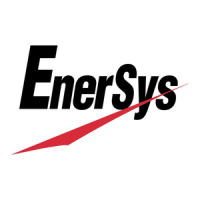350922001-J0 Rev A
Cordex® CXPS-E105 Edge Power Systems
User Guide
7.9. 2 Digital inputs
The factory-installed digital input channels are used to monitor various alarm and control signals. All input
channels are voltage activated and directly accept a bipolar (negative or positive) DC signal.
7.9.3 Analog inputs
The analog input channels are used to monitor various types of electrical signals. Some of the analog channels
are reserved for specific signals, while others are designated as general-purpose inputs, which accommodate
various types of analog signals. The input cables should be bundled together and routed through the entry holes.
Default configurations and terminal numbers described in this chapter have been summarized in the drawings
located at the end of this document.
Voltage input
The voltage input #1 (V1) terminal is located on the shelf to provide connections to an optional secondary voltage
input. For example, this input can be terminated to the load side of an LVD contactor to monitor the load voltage.
Temperature sensor
The temperature sensor input channel (T1) provide connections for a temperature sensor. A voltage is supplied to
these terminals for sensor measurements.
Current input
The current input #1 terminal (I1) is factory wired to the battery shunt.
7.10 CAN serial ports
The CAN serial ports are located on the sides of each rectifier shelf. CAN serial ports are modular jacks with
center latches that are used to communicate with the rectifiers and other CAN-enabled equipment (nodes) on the
same system.
This system has a limit of four rectifiers installed. They do not have self-powered CAN bus nodes.
7.10.1 CAN termination
A CAN termination jumper is located beside each of the CAN serial port jacks on the rectifier shelves. See the
customer connection drawing and schematic that describes your system at the rear of this manual.
7.11 Network and remote communication
The system can be set up, monitored and tested via an Ethernet IEEE 10/100 BASE-T serial data connection and
accessed via the controller or a web interface. Pin-outs are shown in the customer connections drawing.
Some standard scenarios are described:
• Network connection: The Ethernet port is designed to connect the controller to a user supplied network
(TCP/IP supplied by the user) via a front panel RJ45 port. Use a standard network cable for this connection.
• Local connection: The Ethernet port can also be used for local access such as using a laptop computer. Use
a standard Ethernet cable for this connection.

